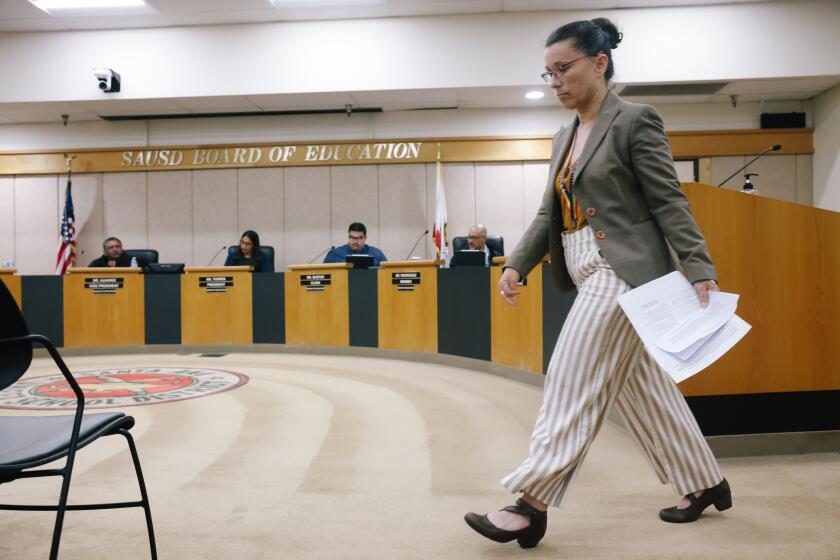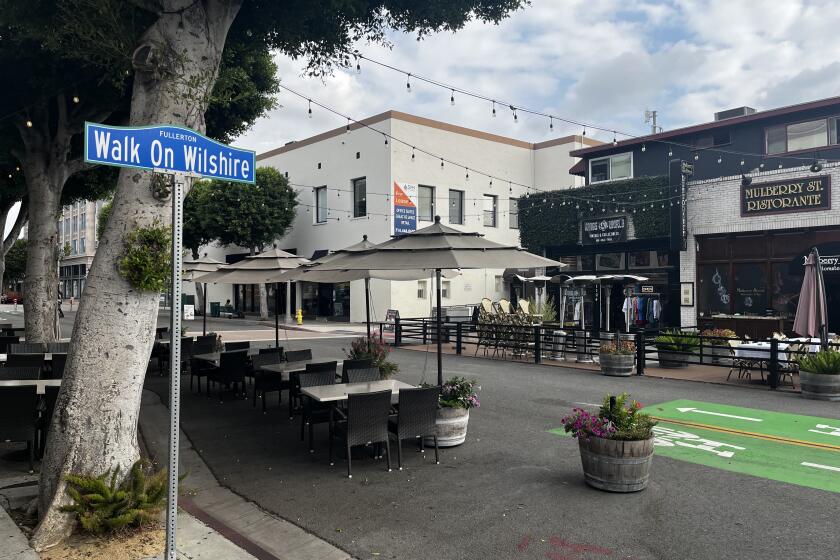Dino Perez tells a story of movement and migration with ‘Baile / Caile’ in Santa Ana

- Share via
When Dino Perez was growing up as an immigrant in Orange County in the 1990s, he looked forward to the parties his classmates would throw during school hours. These “kickbacks” or “ditch parties” were a way to relax from the immense amount of responsibility and pressure he said first-generation kids like himself felt at the time.
“There was a lot of heavy expectations because of all the sacrifice made by immigrant parents,” said Perez.
At the same time, his parents were letting off steam in a similar way, attending dances or “bailes” in Santa Ana and Anaheim, cities that became hubs for Latino immigrant communities.
The parallels between the party styles of the two generations and the way they define movement and migration is the subject of Perez’s latest exhibition, “Baile / Caile,” on view through May 11 at Santa Ana’s Grand Central Art Center.
“The word ‘baile’ always stuck with me because it is such a strong word, and ‘caile’ is Spanish slang for ‘come kick it,’” said Perez. “I like the way that those words rhyme and the way they are both inviting people to come hang out.”

Perez is a well-known local artist, born and raised in Santa Ana where he has a studio space. He was an artist-in-residence at Grand Central Art Center through a partnership with nonprofit Community Engagement from 2016 to 2018, and his art is recognized throughout the city.
The inspiration for “Baile / Caile” was sparked by a memory unlocked when Perez participated in Orange County Center for Contemporary Art’s group show “Original Sources” in October. His found-object installation included imagery from his childhood as well as photos of his parents dancing. When his parents came to see that exhibition, he asked if they remembered where the photo was taken. The answer was El Conejo Feliz in Anaheim, a Mexican restaurant that doubled as a nightclub in the evenings.
“Growing up, my parents would always go out dancing at El Festival in Santa Ana, which is still open, and they would also go to El Conejo Feliz in Anaheim, which is no longer there,” said Perez.
A hot pink dance step chart on the floor of the gallery demonstrates the 12-mile distance from the centers of Santa Ana and Anaheim.
“It also ties in the feeling of movement and migration, how people left Mexico, came to Orange County, settled in Santa Ana and settled in Anaheim and going back and forth between these two spaces,” said Perez. “Dancing for me has always been a form of escapism as a kid and as an adult. It is about finding small moments of joy.”

Perez relates the dances his parents attended to the dance parties he attended in his youth, usually held at a friend’s house or some other secluded public space during school hours. While immigrant parents danced to cumbias, their kids danced to techno and house music.
“There would be dancing, drinking, smoking,” said Perez. “It was the biggest form of escapism for a teenager that has no control over anything, living in constant fear of immigration for friends and family.”
Perez believes both generations were using the social gatherings as a way to relax and have fun, at a time when so much of their lives was full of stress and risk.
“For me the work reminds me of growing up when Proposition 187, a racist, anti-immigrant proposition was on the ballot in California,” said Perez.
In 1994, the ballot initiative sought to establish a state-run citizenship screening system that would prevent illegal immigrants from using non-emergency healthcare, public education and other services in the state. While the proposition did pass, it was ultimately found unconstitutional by a federal district court. With the current administration’s hard line on immigration, Perez said the tension within immigrant communities is familiar, making instances of escapism even more necessary.

“Now with everything going on, it is important to find moments of joy with dance and celebration,” said Perez. “Thirty-one years later, the same fears I had as a kid, now my nieces and nephews have.”
Neon images with psychedelic cartoon characters mirror the often hand-drawn fliers of rave or ditch party culture, where Betty Rubble might have pinwheel eyes or Big Bird might be faded. “Party crews” who planned the underground parties in backyards, parking lots and warehouses would distribute the fliers to spread the word in a time before text messaging. Among the drawings are hand-drawn signs advertising “bailes” the way Perez recalls seeing them posted.
“It feels like a coming of age because I grew up with these cartoons, drawing them, and they meant a lot to me as a kid,” said Perez. “Then as a teenager, they were being used in a different way to promote ditch parties and raves, and I started seeing these characters in a different way.”
Other pieces in the exhibition include beaded necklaces reminiscent of ’90s rave style, with colorful beads, cartoon figures and pacifiers popularized by “groovers,” “ravers” and other youth subcultures. There are also backpacks made out of kids cereal boxes and duct tape, a practice that was popular in rave culture. The backpacks as a utilitarian object represent another aspect of the parallels between the two generations.

“To me the backpack is an important symbol of migration, and here they are piled in exhaustion because of what they symbolize for the kids that were partying and what they symbolize for their parents that migrated to be here,” said Perez.
The necklaces and backpack were a way to identify a party crew or a peer who was also into the underground party scene. A collection of hats in the gallery demonstrates another way the community represented itself.
“Party crews would rep their crew on their hats, embroidered with their name and a lot of times Mexican flag colors were used,” said Perez.
The black baseball cap-style hats with El Conejo Feliz and El Festival stitched on them blend the two generations.
“I noticed the Zip Codes of El Conejo Feliz and El Festival were really similar, so I merged them together using the 92701 and the 92801 to make a hat that says 927801,” said Perez.

The entire collection ties together key tenants of Perez’s work that touch on memory, politics and community. He hopes the exhibition inspires viewers to reflect on local subcultures that sprout out of a means of survival and how our current environment makes finding those releases necessary still.
“I hope that people that connect with the work and find some joy in it,” said Perez. “Because we need it.”
“Baile / Caile” is on view now through May 11 at Grand Central Art Center, located at 125 N. Broadway in Santa Ana.
All the latest on Orange County from Orange County.
Get our free TimesOC newsletter.
You may occasionally receive promotional content from the Daily Pilot.




